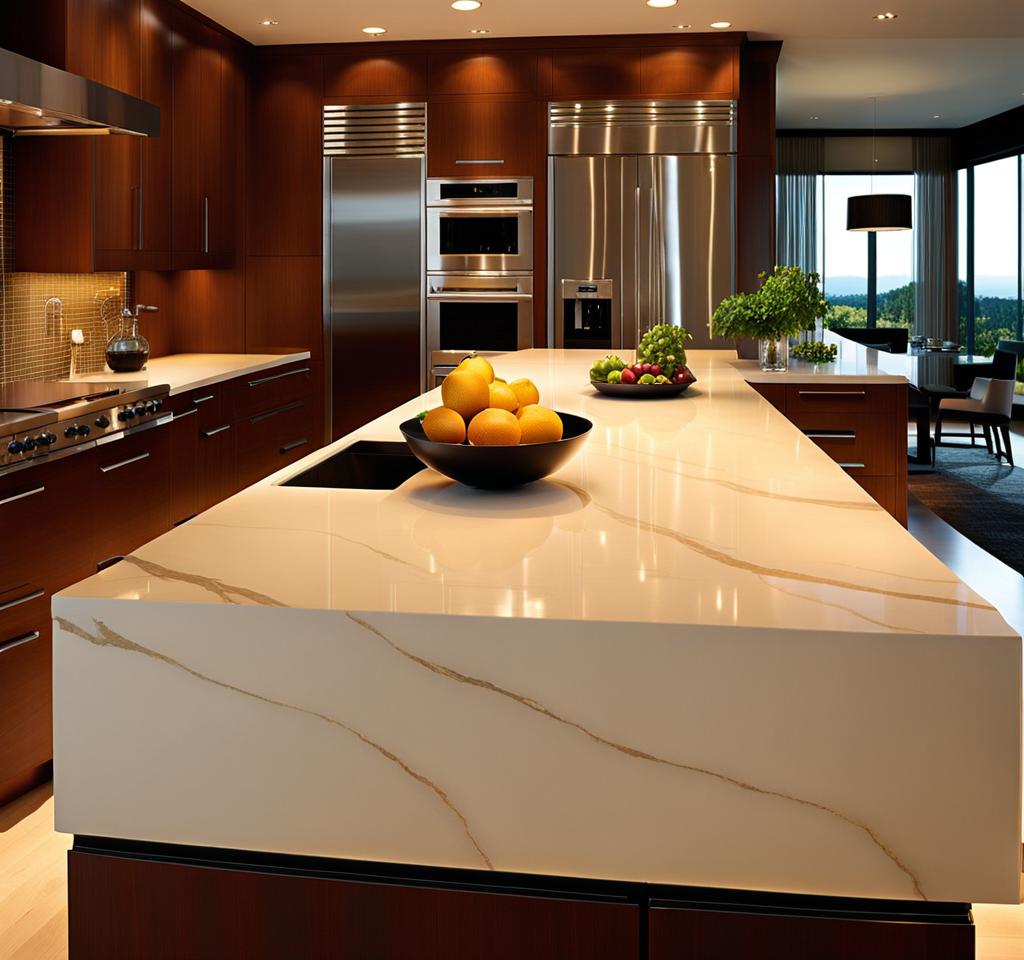When it comes to designing a functional and aesthetically pleasing kitchen, one crucial aspect that often gets overlooked is the height of kitchen countertops. As an interior design expert, I cannot emphasize enough the importance of getting this detail right. The countertop height plays a pivotal role in ensuring not only visual harmony but also optimal ergonomics and workflow efficiency.
Ergonomic Considerations for Kitchen Countertop Heights
Proper ergonomics should be the top priority when determining the ideal height for your kitchen countertops. The goal is to create a comfortable and efficient workspace that minimizes strain on your back, shoulders, and arms during food preparation tasks. Standard countertop heights typically range from 34 to 36 inches, but this may not suit everyone’s needs.

Your personal height and the tasks you perform in the kitchen should be the guiding factors. For instance, if you’re taller than average, a higher countertop might be more suitable to prevent excessive bending or hunching over. Conversely, shorter individuals may benefit from a slightly lower counter to reduce the need for constant reaching or straining.
Additionally, consider the layout of your kitchen and the flow of movement. Strategically placed countertops at varying heights can facilitate seamless transitions between different work zones, such as prep areas, cooking stations, and cleanup zones. This thoughtful design approach can significantly enhance overall comfort and efficiency.
Aesthetic Impact of Kitchen Countertop Heights
While functionality is paramount, the aesthetic impact of countertop heights cannot be overlooked. The right countertop height can contribute to a visually appealing and cohesive design that complements the overall kitchen style and cabinetry.
Aim for a harmonious balance between the countertop height and the surrounding elements, such as upper cabinets, appliances, and backsplashes. A well-proportioned kitchen with properly scaled countertops can create a sense of order and elegance, elevating the entire space.
Experiment with different countertop heights to find the perfect combination that suits your design preferences and the kitchen’s architectural features. For instance, a slightly higher countertop can create a more substantial and grounded look, while a lower counter can lend an airy and open feel to the space.
Customizing Countertop Heights for Unique Needs
In today’s modern kitchens, one-size-fits-all solutions are becoming increasingly obsolete. Homeowners are embracing the opportunity to customize their kitchen layouts and countertop heights to cater to their unique needs and preferences.
- Multi-level countertops: Consider incorporating varying heights within the same kitchen for different tasks or users. This approach can accommodate both taller and shorter individuals, ensuring everyone has a comfortable workspace.
- Islands and peninsulas: These freestanding countertop areas lend themselves well to customized heights, allowing for a dedicated prep or casual dining space tailored to your specific requirements.
- Accessibility considerations: If you or a family member has mobility challenges, adjustable or lower countertop heights can significantly improve accessibility and make daily tasks more manageable.
By embracing customization, you can create a kitchen that truly serves your lifestyle and meets the unique needs of your household.
Impact of Countertop Heights on Kitchen Workflow
The height of your kitchen countertops can have a profound impact on the overall workflow and efficiency within the space. Properly designed countertop heights can streamline food preparation tasks, minimize unnecessary movements, and enhance your productivity.
Consider the relationship between the counter height and the heights of your appliances, such as the stovetop, oven, and refrigerator. Ensuring a seamless transition between these elements can significantly reduce strain and improve the overall ergonomics of your kitchen tasks.
Additionally, pay close attention to the counter-to-counter flow. Strategically positioning prep areas, cooking stations, and cleanup zones at appropriate heights can create a natural and intuitive workflow, minimizing the need for excessive reaching, bending, or carrying items across the kitchen.
Trends and Innovations in Kitchen Countertop Heights
The world of kitchen design is constantly evolving, and countertop heights are no exception. Contemporary design solutions are pushing the boundaries of traditional approaches, offering innovative and adaptive solutions to meet diverse needs.
- Adjustable countertops: These cutting-edge designs allow homeowners to customize the countertop height with the push of a button, catering to different users or tasks seamlessly.
- Multi-level countertops: Rather than a uniform height throughout, multi-level countertops incorporate varying heights within the same kitchen layout, creating distinct zones for specific tasks or users.
- Accessibility and universal design: With an increasing emphasis on inclusivity, many manufacturers are offering countertop options that adhere to accessibility and universal design principles, ensuring comfortable usage for individuals with varying abilities.
By embracing these trends and innovations, you can future-proof your kitchen and create a space that adapts to your changing needs over time.
Once you’ve determined the ideal countertop heights for your kitchen, careful planning and execution are crucial to ensure a successful installation. Start by taking precise measurements of your space and consulting with professional contractors or kitchen designers.
These experts can provide valuable insights and recommendations based on industry standards, local building codes, and your specific requirements. They can also guide you through the selection of appropriate materials, construction techniques, and any necessary modifications to existing cabinetry or infrastructure.
If you’re retrofitting an existing kitchen, be prepared for potential challenges and additional costs associated with altering countertop heights. However, the investment can be well worth it in terms of improved comfort, functionality, and overall satisfaction with your kitchen.
Remember, achieving the ideal countertop height is a balance of ergonomics, aesthetics, and personal preferences. With thoughtful planning and attention to detail, you can create a kitchen that not only looks stunning but also provides a comfortable and efficient workspace tailored to your unique needs.

This is where you’ll find inspiration to create a stylish and beautiful dream home.